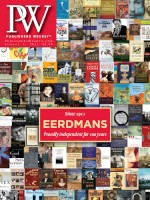E-books and online retailers showed strong market share gains in the first quarter of 2011 compared to the first period of 2010, while book clubs and hardcovers had noticeable declines. Those were some of the shifts in trends derived from Bowker's PubTrack Consumer service.
According to PubTrack, e-books represented 6.4% of dollar sales in the first quarter of 2011 compared to 1.6% in last year's first period, while online retailers' share of sales increased to 35.3% from 26.3% year over year. Online retailers benefited from the increasing popularity of e-books and also have grabbed a growing share of print book sales.
The biggest loser among market channels in the first quarter was book clubs, whose market share tumbled from 9.6% in last year's first quarter to 2.8% in this year's first period. The major bookstore chains held their own in the first quarter as the full impact of Borders's first round of store closings wasn't really felt until the second quarter. Still, with the jump in sales of online retailers and the minor decline in sales through the bookstore chains, the e-commerce sales channel overtook the bricks-and-mortar stores as the largest sales channel for book purchases at the start of the year. While the chains had some erosion in market share in the quarter, independent bookstores picked up just over one full percentage point compared to a year ago and held a 6.2% share of book spending.
Unit shifts among market channels mirrored the changes seen in sales. Book clubs' share of units fell from 10.5% in last year's first quarter to 5.3% in the 2011 comparable quarter. The e-commerce channel showed a big jump in unit market share—from 23.4% to 32.8%—while the chains' share of unit sales was about flat.
In terms of formats, the gains in e-books came at the expense of hardcovers and mass market paperbacks. The hardcover segment's share of spending fell to 37.8%, from 42.0%, while the mass market paperback segment's share dropped to 7.0% from 8.3%. The trade paperback category had a gain, with its share of spending rising from 35.6% to 38.0% in the 2011 first quarter.
E-books' impact on the market was more pronounced on unit sales than on spending. While e-books represented 6.4% of spending in the quarter, according to PubTrack, they represented 12.9% of unit sales, up from 2.5% a year earlier. But with the average price of an e-book falling to $5.60, e-books' share of spending represented only about half of its share of units sold. The market share of all print segments based on units fell in the first quarter, with hardcover units down the most, at over six percentage points. Mass market paperback unit sales dropped to 14.9% from 18.1%, while trade paperback units slipped to 34.6% from 35.2%.
The $5.60 average price of an e-book in this year's first quarter was down from $7.79 in the first period of 2010 and reflects the growing number of lower-priced backlist titles, original e-books, and short-form digital works that are now available. Another significant change in pricing was in audio, where spending per title dropped from $19.94 in last year's first quarter to $11.21 in this year's first period, no doubt due to the increase in sales of less expensive digital downloads.



 Volume 258
Issue 31
08/01/2011
Volume 258
Issue 31
08/01/2011





